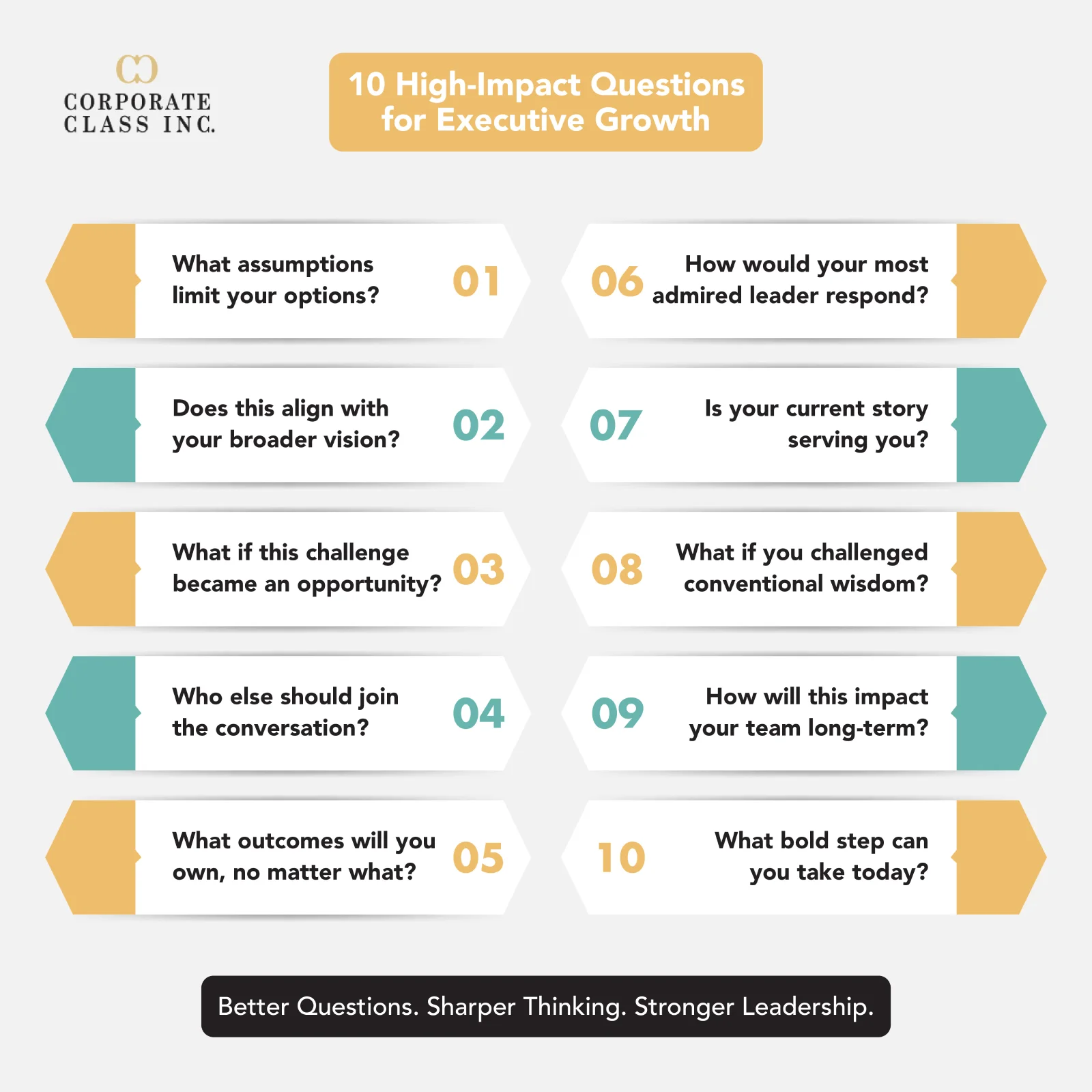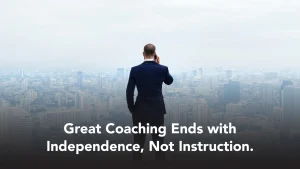Executive growth starts with asking sharper questions, not giving faster answers. The most effective leaders learn to replace directives with inquiry, using powerful questions to unlock insight, accountability, and direction. This approach drives better thinking, improves team decision-making, and strengthens organizational alignment. In this article, you’ll learn how the right questions reshape leadership influence, expose blind spots, and drive measurable business impact.
Key Takeaways
- High-impact questions fuel executive growth by shifting thinking from reaction to reflection.
- The right inquiries uncover assumptions, strengthen decisions, and align long-term strategy.
- Asking with intent transforms communication, building clarity, trust, and stronger leadership results.
Understanding Questions to Inspire Executive Growth Instead of Giving Advice
Executives are often expected to have every answer. Yet the highest-performing leaders know that great leadership begins with great inquiry. Asking the right questions moves teams from compliance to ownership and transforms coaching from direction into dialogue.
When you replace advice with inquiry, you activate independent thinking. People take more responsibility for their decisions because they helped shape them. The result is a more agile, innovative culture where solutions come from collaboration, not command.
Curiosity drives growth. Questions expand awareness and reframe challenges as opportunities. They prompt reflection, reveal assumptions, and encourage adaptive thinking. The shift from telling to asking builds psychological safety and deepens engagement across every leadership tier.
Revealing Executive Blind Spots with the Right Inquiries
Blind spots exist even in the most experienced leaders. The right questions bring them to light. Instead of relying on feedback alone, inquiry helps leaders self-assess in real time. When used consistently, this technique improves decision quality and strengthens self-awareness.
Here are examples of targeted questioning techniques that expose barriers to growth:
- Clarifying assumptions: Helps you identify what beliefs drive decisions and where bias may exist.
- Reframing obstacles: Turns reactive thinking into proactive problem-solving.
- Identifying inconsistencies: Encourages accountability by challenging gaps between intent and action.
- Encouraging perspective-taking: Opens dialogue to understand how others experience your leadership.
- Prioritizing reflection: Promotes continuous learning instead of one-time performance reviews.
These techniques don’t criticize performance; they guide it. The goal is awareness that leads to better choices and stronger follow-through.
Using 10 High-Impact Questions to Shift Mindsets and Strategic Direction

High-impact questions reframe how leaders think, decide, and act. They interrupt autopilot decision-making and ignite reflection that leads to better choices. When you ask rather than instruct, you shift ownership from compliance to commitment. These ten questions help executives build sharper awareness, drive clarity, and encourage strategic accountability across every level of an organization.
They work because they replace reaction with reflection. They expose bias, stretch perspective, and redirect energy toward purposeful action. Used consistently, they change how leaders process information, moving from habitual responses to deliberate, forward-focused reasoning.
1. What assumptions limit your options?
Executives often operate under invisible constraints shaped by past experiences or organizational norms. This question dismantles those barriers by challenging what’s taken for granted. It opens creative pathways by asking, “What if my current logic is incomplete?” Once assumptions are tested, possibilities expand. It’s the difference between managing within limits and leading beyond them, a vital driver for executive growth.
2. Does this align with your broader vision?
This question reconnects immediate choices to strategic purpose. It prevents leaders from being consumed by short-term fires or reactive agendas. Every decision that aligns with vision strengthens consistency, credibility, and direction. The most successful executives use this question as a mental checkpoint, ensuring each action reinforces the organization’s long-term positioning.
3. What if this challenge became an opportunity?
Reframing is one of the most valuable executive skills. When a leader trains their mind to ask this question, adversity becomes a strategic lever. It transforms moments of tension into opportunities for creativity and resilience. This mindset helps teams see obstacles as innovation triggers, not interruptions, a key differentiator between reactive managers and adaptive leaders.
4. Who else should join the conversation?
High-performing executives know that strategic insight thrives on diversity of thought. This question challenges isolation and encourages collaboration across functions. It ensures decisions are shaped by multiple perspectives rather than limited by hierarchy. By asking it, you invite inclusivity, expand accountability, and often discover blind spots that only emerge through collective intelligence.
5. What outcomes will you own, no matter what?
Accountability defines leadership integrity. This question cuts through ambiguity by clarifying what you will personally guarantee. It’s not just about responsibility, it’s about reliability. When leaders declare ownership of specific outcomes, teams gain confidence in direction and commitment. It reinforces consistency and transforms words into measurable action.
6. How would your most admired leader respond?
This question serves as an ethical compass. By envisioning the reaction of someone you respect, you align with higher standards of leadership behaviour. It helps filter impulsive reactions and encourages thoughtful responses. Over time, it builds emotional discipline, a quality that defines leaders who lead by principle, not pressure.
7. Is your current story serving you?
Every executive carries a narrative that shapes how they lead. This question uncovers outdated beliefs that may no longer align with your role, goals, or growth. It asks you to assess whether your internal dialogue still matches the external demands of leadership. By rewriting your story consciously, you strengthen confidence and expand capacity for change.
8. What if you challenged conventional wisdom?
Innovation thrives on disruption. Questioning standard practices doesn’t mean dismissing them; it means stress-testing them. This question promotes intellectual courage, helping leaders push boundaries responsibly. It’s how forward-thinking executives stay ahead of industry shifts instead of reacting to them.
9. How will this impact your team long-term?
Strategic leaders think in timelines, not moments. This question forces perspective beyond the immediate gain. It prompts evaluation of how today’s decision influences culture, morale, and performance months or years later. When you plan through the lens of long-term team impact, every action becomes both purposeful and sustainable.
10. What bold step can you take today?
Momentum drives change. This question translates reflection into immediate action, cutting through hesitation. It reminds leaders that progress doesn’t always require a perfect plan, only the courage to begin. Each bold step compounds over time, proving that executive growth accelerates when thought and action move in tandem.
These ten questions are not rhetorical; they are operational tools. Use them in boardrooms, coaching sessions, and strategic reviews. They will help you steer dialogue toward accountability, innovation, and impact. When asked with consistency and intent, they redefine how you approach leadership, strategy, and personal performance. They turn awareness into influence and insight into measurable executive growth.
Mastering Timing and Tone: When to Ask and When to Hold Back
Powerful inquiry isn’t just about what you ask, it’s about when and how you ask it. The same question can inspire clarity or trigger defensiveness, depending on timing and delivery. Mastering this skill separates good communicators from exceptional leaders.
In high-stakes environments, timing determines impact. Asking too early risks disrupting thought flow; asking too late means missing the moment. Great leaders read emotional cues before engaging. They assess readiness, tone, and context, using empathy as a diagnostic tool for precision communication.
Best Practices for Effective Timing and Tone
Tone carries equal weight. A curious, calm delivery transforms a question into collaboration. A sharp tone turns it into a confrontation. When you phrase questions as open invitations rather than subtle challenges, you create space for reflection and dialogue instead of reaction.
- Ask after listening: The person must feel fully heard before a question can add value. Listening establishes trust and signals genuine interest.
- Pause intentionally: Silence is strategic. It gives others the cognitive space to think deeply and respond meaningfully.
- Use neutral phrasing: Replace emotionally charged language with balanced wording to encourage honesty and openness.
- Avoid stacking questions: One clear question at a time prevents confusion and keeps discussions focused.
- Match tone to context: Use a supportive tone during reflection and a decisive tone during execution discussions.
When used with empathy and awareness, inquiry becomes a leadership advantage. Well-timed questions build respect, lower resistance, and spark higher-quality thinking. Over time, this skill cultivates psychological safety and transforms communication from directive to developmental.
Applying Powerful Inquiry Skills in Everyday Executive Communication
Inquiry doesn’t belong only in coaching sessions; it belongs in daily leadership. When integrated into communication, it increases transparency, drives alignment, and enhances decision-making speed. Asking before advising improves collaboration across every level of the organization.
Powerful questioning in daily operations creates accountability and trust. It helps leaders clarify expectations, identify obstacles early, and strengthen team problem-solving. It transforms meetings from report sessions into innovation discussions.
- Start meetings with curiosity: Replace updates with questions that drive reflection.
- Use inquiry to delegate: Ask how others plan to approach a task instead of prescribing the method.
- Revisit performance goals through questioning: Encourage employees to assess their own progress.
- Close conversations with reflection: End discussions by asking what action each person will take next.
When inquiry becomes part of culture, communication shifts from transactional to strategic. Every conversation becomes a chance to influence growth and performance.
FAQ
How do high-impact questions support executive growth?
They promote self-awareness, accountability, and innovation. Instead of focusing on immediate answers, these questions help leaders reflect strategically and align actions with broader goals.
Can questioning replace traditional performance coaching?
No, questioning complements coaching. It transforms coaching from a directive exchange into a discovery process, creating ownership and sustainable behavioural change.
How often should leaders use these questions?
Regularly. Incorporating one or two questions into weekly check-ins or team discussions builds a continuous culture of reflection and improvement.
Driving Executive Growth Through Better Questions
Growth begins with curiosity. When you replace advice with inquiry, leadership becomes more engaging, adaptive, and effective. Each powerful question expands awareness, strengthens communication, and reinforces strategic clarity. Start today by asking one of the ten questions, and notice how quickly thinking sharpens, collaboration deepens, and executive growth accelerates.





